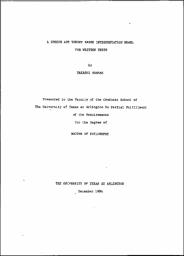
ATTENTION: The works hosted here are being migrated to a new repository that will consolidate resources, improve discoverability, and better show UTA's research impact on the global community. We will update authors as the migration progresses. Please see MavMatrix for more information.
Show simple item record
| dc.contributor.author | Manabe, Takashi | |
| dc.date.accessioned | 2020-10-12T15:07:14Z | |
| dc.date.available | 2020-10-12T15:07:14Z | |
| dc.date.issued | 1984-12 | |
| dc.identifier.uri | http://hdl.handle.net/10106/29512 | |
| dc.description.abstract | In recent years, so called Speech Act Theory (a branch of the philosophy of language) has focused on such concepts as 'intention' (or 'intentionality'), 'interaction' and 'comprehension'. The author believes that this theory gives the theoretical basis for an interpretation model which is developed in this study. After human speech activities are placed in the larger context of human actions, a model which explains the performing process of speech acts is presented. In this model, four levels of intentionality are posited: utterance intent, propositional intent, illocutionary intent, and perlocutionary intent. These levels of intentionality are inseparable from each other and operate simultaneously in performing speech acts. Speech acts are categorized according to their illocutionary intents. Six major categories are suggested: Representatives, Directives, Commissives, Expressives, Declarations, and Responsives. The model of the speaker presented above is completed when the model of the hearer (or interpreter) is added to it. The combined model, which can be called a cyclic or interactive model, is developed. Corresponding to the four levels of intentions on the part of the speaker, four levels of effects are posited in order to explain the 'comprehension' process of the hearer. These four levels of effects are: utterance effect, propositional effect, illocutionary effect, and perlocutionary effect. It is contended that only after this stage of comprehension can the hearer make a legitimate response to the speaker by his 'decision' and 'response action'. The process of comprehension, then, is explained extensively, paying particular attention to the concepts of 'context' and 'inference'. The main contributions of the study are: (i) the resolutions of some of the lingering theoretical problems in Speech Act Theory; (ii) the development of an interactive model of speech acts, which is applied to text analysis; and (iii) the development of such concepts as 'author's intent structure' and 'referential intent structure' for the application of Speech Act Theory to text analysis. | en_US |
| dc.language.iso | en_US | en_US |
| dc.publisher | University of Texas at Arlington | en_US |
| dc.subject | Language | en_US |
| dc.subject | Literature and linguistics | en_US |
| dc.title | A SPEECH ACT THEORY BASED INTERPRETATION MODEL FOR WRITTEN TEXTS | en_US |
| dc.type | Dissertation | en_US |
| thesis.degree.department | Humanities | |
| thesis.degree.name | Doctor of Philosophy in Humanities | |
Files in this item
- Name:
- A Speech Act Theory Based ...
- Size:
- 14.23Mb
- Format:
- PDF
- Description:
- PDF
This item appears in the following Collection(s)
Show simple item record


